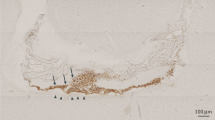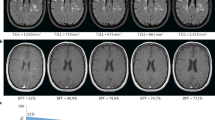Abstract
Baló's concentric sclerosis (BCS) has long been considered to be a variant of multiple sclerosis. Although BCS was initially described over 100 years ago, relatively few antemortem cases have been identified, and the exact pathogenesis remains unknown. Inflammatory protective ischemic preconditioning has recently been suggested as a mechanism by which the typical concentric rings of the BCS lesion are formed. Advanced neuroimaging can provide important in vivo markers of disease progression that can assist in the diagnosis and management of patients with BCS. In this Review, we discuss evidence from longitudinal neuroimaging studies that supports the role of ischemic preconditioning in BCS.
Key Points
-
The lesion in Baló's concentric sclerosis (BCS) is characterized by a pattern of concentric alternating bands of myelinated and partially demyelinated neurons
-
Ischemic preconditioning proteins might protect against demyelination in an outwardly expanding BCS lesion, causing the formation of a 'spared' ring of myelinated tissue surrounded by another ring of demyelination outside of the region of protection
-
It is difficult to clinically distinguish BCS from other demyelinating diseases such as acute disseminated encephalomyelitis and multiple sclerosis; MRI is needed to confirm the diagnosis
-
Restricted diffusion, indicative of cytotoxic edema typically associated with ischemia, has now been reported in several BCS cases
-
Magnetic resonance spectroscopy shows that acute BCS lesions have decreased N-acetylaspartate peaks (consistent with neuronal loss), increased choline and lipid peaks (suggestive of increased cell membrane turnover and gliosis), and increased lactate peaks (consistent with impaired aerobic metabolism)
-
Ischemia is likely to have a role in the pathogenesis of BCS and pattern type III multiple sclerosis lesions
This is a preview of subscription content, access via your institution
Access options
Subscribe to this journal
Receive 12 print issues and online access
$209.00 per year
only $17.42 per issue
Buy this article
- Purchase on Springer Link
- Instant access to full article PDF
Prices may be subject to local taxes which are calculated during checkout



Similar content being viewed by others
References
Karaarslan E et al. (2001) Baló's concentric sclerosis: clinical and radiologic features of five cases. AJNR Am J Neuroradiol. 22: 1362–1367
Anschel DJ (2006) Reply to the paper by Wiendl et al.: diffusion abnormality in Baló's concentric sclerosis: clues for the pathogenesis. Eur Neurol. 55 : 111–112
Mowry EM et al. (2007) Baló's concentric sclerosis presenting as a stroke-like syndrome. Nat Clin Pract Neurol 3: 349–354
Brinar VV (2004) Non-MS recurrent demyelinating diseases. Clin Neurol Neurosurg. 106: 197–210
Brinar VV and Poser CM (2006) The spectrum of disseminated encephalomyelitis. Clin Neurol Neurosurg. 108: 295–310
Poser CM and Brinar VV (2004) The nature of multiple sclerosis. Clin Neurol Neurosurg. 106: 159–171
Yao DL et al. (1994) Concentric sclerosis (Baló): morphometric and in situ hybridization study of lesions in six patients. Ann Neurol. 35: 18–30
Moore GR et al. (1985) Baló's concentric sclerosis: new observations on lesion development. Ann Neurol. 17: 604–611
Chen CJ et al. (1999) Serial magnetic resonance imaging in patients with Baló's concentric sclerosis: natural history of lesion development. Ann Neurol. 46: 651–656
Moore GR et al. (2001) Baló's concentric sclerosis: surviving normal myelin in a patient with a relapsing–remitting clinical course. Mult Scler. 7: 375–382
Khonsari RH and Calvez V (2007) The origins of concentric demyelination: self-organization in the human brain. PloS ONE. 2: e150
Stadelmann C et al. (2005) Tissue preconditioning may explain concentric lesions in Baló's type of multiple sclerosis. Brain. 128: 979–987
Sekijima YM et al. (1997) Serial magnetic resonance imaging (MRI) study of a patient with Baló's concentric sclerosis treated with immunoadsorption plasmapheresis. Mult Scler. 2: 291–294
Chen CJ (2001) Serial proton magnetic resonance spectroscopy in lesions of Baló concentric sclerosis. J Comput Assist Tomogr. 25: 713–718
Gu J et al. (2003) Concentric sclerosis: imaging diagnosis and clinical analysis of 3 cases. Neurol India. 51: 528–530
Chen CJ et al. (1996) Serial MRI studies in pathologically verified Baló's concentric sclerosis. J Comput Assist Tomogr. 20: 732–735
Kim MO et al. (1997) Baló's concentric sclerosis: a clinical case study of brain MRI, biopsy, and proton magnetic resonance spectroscopic findings. J Neurol Neurosurg Psychiatry. 62: 655–658
Murakami Y et al. (1998) Baló's concentric sclerosis in a 4-year-old Japanese infant. Brain Dev. 20: 250–252
Singh S et al. (1999) Baló's concentric sclerosis: value of magnetic resonance imaging in diagnosis. Australas Radiol. 43: 400–404
Pohl D et al. (2005) Baló's concentric sclerosis associated with primary human herpesvirus 6 infection. J Neurol Neurosurg Psychiatry. 76: 1723–1725
Wiendl H et al. (2005) Diffusion abnormality in Baló's concentric sclerosis: clues for the pathogenesis. Eur Neurol. 53: 42–44
Tersegno MM and Reich DR (1993) Baló's concentric sclerosis: a rare form of multiple sclerosis manifested as a dominant cerebral mass without other white matter lesions on MR. AJR Am J Roentgenol. 160: 901
Chen CJ et al. (1996) Baló's concentric sclerosis: MRI. Neuroradiology. 38: 322–324
Gharagozloo AM et al. (1994) Antemortem diagnosis of Baló concentric sclerosis: correlative MR imaging and pathologic features. Radiology. 191: 817–819
Ng SH et al. (1999) MRI features of Baló's concentric sclerosis. Br J Radiol. 72: 400–403
Caracciolo JT et al. (2001) Pathognomonic MR imaging findings in Baló concentric sclerosis. AJNR Am J Neuroradiol. 22: 292–293
Kastrup O et al. (2002) Baló's concentric sclerosis: evolution of active demyelination demonstrated by serial contrast-enhanced MRI. J Neurol. 249: 811–814
Nagi S et al. (2005) Baló's concentric sclerosis in a North-African patient [French]. Rev Neurol (Paris). 161: 78–80
Spiegel M et al. (1989) MRI study of Baló's concentric sclerosis before and after immunosuppressive therapy. J Neurol. 236: 487–488
Iannucci G et al. (2000) Vanishing Baló-like lesions in multiple sclerosis. J Neurol Neurosurg Psychiatry. 69: 399–400
Louboutin JP and Elie B (1995) Treatment of Baló's concentric sclerosis with immunosuppressive drugs followed by multimodality evoked potentials and MRI. Muscle Nerve. 18: 1478–1480
Weber R et al. (2006) Present status of magnetic resonance imaging and spectroscopy in animal stroke models. J Cereb Blood Flow Metab. 26: 591–604
Kuker W et al. (2004) Modern MRI tools for the characterization of acute demyelinating lesions: value of chemical shift and diffusion-weighted imaging. Neuroradiology. 46: 421–426
Petzold GC et al. (2005) Diffusion-weighted magnetic resonance imaging of acute disseminated encephalomyelitis. Eur J Neurol. 12: 735–736
Rosso C et al. (2006) Diffusion-weighted MR imaging characteristics of an acute stroke-like form of multiple sclerosis. AJNR Am J Neuroradiol. 27: 1006–1008
Axer H et al. (2005) Initial DWI and ADC imaging may predict outcome in acute disseminated encephalomyelitis: report of two cases of brain stem encephalitis. J Neurol Neurosurg Psychiatry. 76: 996–998
Balasubramanya KS et al. (2007) Diffusion-weighted imaging and proton MR spectroscopy in the characterization of acute disseminated encephalomyelitis. Neuroradiology. 49: 177–183
Bernarding J et al. (2002) Diffusion- and perfusion-weighted MR imaging in a patient with acute disseminated encephalomyelitis (ADEM). J Magn Reson Imaging. 15: 96–100
Wuerfel J et al. (2004) Changes in cerebral perfusion precede plaque formation in multiple sclerosis: a longitudinal perfusion MRI study. Brain. 127: 111–119
Phuttharak W et al. (2006) ADC measurements in various patterns of MS lesions. J Med Assoc Thai. 89: 196–204
Kavanagh EC et al. (2006) Diffusion-weighted imaging findings in Baló concentric sclerosis. Br J Radiol. 79: e28–e31
Pendlebury ST et al. (2000) Correlating magnetic resonance imaging markers of axonal injury and demyelination in motor impairment secondary to stroke and multiple sclerosis. Magn Reson Imaging. 18: 369–378
Narayana PA (2005) Magnetic resonance spectroscopy in the monitoring of multiple sclerosis. J Neuroimaging. 15 (Suppl): S46–S57
Bizzi A et al. (2001) Quantitative proton MR spectroscopic imaging in acute disseminated encephalomyelitis. AJNR Am J Neuroradiol. 22: 1125–1130
Mader I et al. (2005) MRI and proton MR spectroscopy in acute disseminated encephalomyelitis. Childs Nerv Syst. 21: 566–572
Bruneteau G et al. (2005) Contribution of proton magnetic resonance spectroscopy to the diagnosis of Baló's concentric sclerosis [French]. Rev Neurol (Paris). 161: 455–458
Graham GD et al. (2001) Spectroscopic assessment of alterations in macromolecule and small-molecule metabolites in human brain after stroke. Stroke. 32: 2797–2802
Lassmann H et al. (2001) Heterogeneity of multiple sclerosis pathogenesis: implications for diagnosis and therapy. Trends Mol Med. 7: 115–121
Kornek B and Lassmann H (2003) Neuropathology of multiple sclerosis—new concepts. Brain Res Bull. 61: 321–326
Lucchinetti C et al. (2000) Heterogeneity of multiple sclerosis lesions: implications for the pathogenesis of demyelination. Ann Neurol. 47: 707–717
Aboul-Enein F et al. (2003) Preferential loss of myelin-associated glycoprotein reflects hypoxia-like white matter damage in stroke and inflammatory brain diseases. J Neuropathol Exp Neurol. 62: 25–33
Lassmann H et al. (2003) A new paraclinical CSF marker for hypoxia-like tissue damage in multiple sclerosis lesions. Brain. 126: 1347–1357
Airas L et al. (2005) Successful pregnancy of a patient with Baló's concentric sclerosis. Mult Scler. 11: 346–348
Wakefield AJ et al. (1994) Immunohistochemical study of vascular injury in acute multiple sclerosis. J Clin Pathol. 47: 129–133
Dutta R et al. (2006) Mitochondrial dysfunction as a cause of axonal degeneration in multiple sclerosis patients. Ann Neurol. 59: 478–489
Acknowledgements
The authors would like to thank Dr Steven Galetta and Dr Dina Jacobs for their helpful comments and suggestions. This work was supported by a University-wide AIDS Research Program Grant (CF05-SD-301) and an American Foundation for AIDS Research Grant (106729-40-RFRL), both awarded to BM Ances.
Author information
Authors and Affiliations
Corresponding author
Ethics declarations
Competing interests
The authors declare no competing financial interests.
Supplementary information
Supplementary Table 1
Existing literature of radiological findings associated with Baló's concentric sclerosis. (DOC 161 kb)
Rights and permissions
About this article
Cite this article
Mowry, E., Woo, J. & Ances, B. Technology Insight: can neuroimaging provide insights into the role of ischemia in Baló's concentric sclerosis?. Nat Rev Neurol 3, 341–348 (2007). https://doi.org/10.1038/ncpneuro0519
Received:
Accepted:
Issue Date:
DOI: https://doi.org/10.1038/ncpneuro0519
This article is cited by
-
Atypical Multiple Sclerosis – Baló’s Concentric Sclerosis: Two Case Reports and a Review
Neuroscience and Behavioral Physiology (2018)
-
Balò’s concentric sclerosis: still to be considered as a variant of multiple sclerosis?
Neurological Sciences (2015)
-
Concentric demyelination by self-organization: a new hypothesis for Baló's sclerosis
Nature Clinical Practice Neurology (2007)
-
Baló's concentric sclerosis presenting as a stroke-like syndrome
Nature Clinical Practice Neurology (2007)



